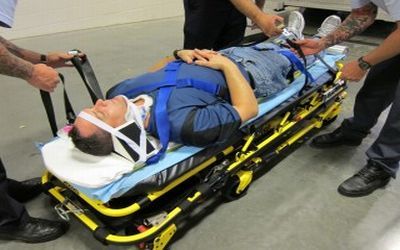New Material Helps Solve Problem of Contaminated Backboards


Some solutions are no-brainers. Take medical backboards, for example, those hard plastic boards used to stabilize patients during emergencies before the patient is lifted onto the gurney and hurried into the ambulance. After each call, technicians scrub down their equipment to avoid exposing the next patient to diseases, microbes or bodily fluids, but despite these efforts, a study conducted in partnership with the University of Miami examined 55 "cleaned" active-duty backboards and found that every backboard was contaminated with at least 11 different strains of microorganisms.
To solve this problem and eliminate cross-contamination, Scott Neusch, a retired firefighter and paramedic from Orlando, Fla. submitted an idea for a backboard cover to the U.S. Department of Homeland Security (DHS) Science and Technology Directorate (S&T). S&T's program for first responders, TechSolutions, works to provide solutions to technology gaps identified by first responders, such as Neusch. S&T's TechSolutions team researched the market to determine the novelty and value to EMS responders for a backboard cover, and conducted a focus group of EMS responders who validated and improved upon the idea.
The result is Board Armor a synthetic material disposable backboard cover that reduces infection rates in patients and saves valuable emergency response time. It is made of a non-porous medical-grade material that prevents bodily fluids from contaminating the backboard itself and eliminates the need to clean the backboard between each use. Board Armor provides a clean surface for a patient to lie on and reduces turnaround time for Emergency Medical Service providers.
DHS S&T has developed a number of tools to support the first responder community through the TechSolutions program, including Multi-Band Radio Technology, which enables emergency responders to communicate with partner agencies regardless of the radio band on which they operate, as well as the Next Generation Self-Contained Breathing Apparatus that incorporates new pressure vessel technology allowing emergency responders to experience less stress, be able to move more easily in confined spaces and avoid entanglement, and to operate more safely in hazardous response environments.
To learn more about the TechSolutions program, visit www.FirstResponder.gov.
Vet IP Roundtable 2: Infection Control and Biosecurity Challenges in Veterinary Care
March 31st 2025Veterinary IPs highlight critical gaps in cleaning protocols, training, and biosecurity, stressing the urgent need for standardized, animal-specific infection prevention practices across diverse care settings.
Invisible, Indispensable: The Vital Role of AHRQ in Infection Prevention
March 25th 2025With health care systems under strain and infection preventionists being laid off nationwide, a little-known federal agency stands as a last line of defense against preventable patient harm. Yet the Agency for Healthcare Research and Quality (AHRQ) is now facing devastating cuts—threatening decades of progress in patient safety.
The Sterile Processing Conference Survival Guide: How to Make the Most of Your Next Event
March 25th 2025From expert speakers to cutting-edge tools, sterile processing conferences, like the 2025 HSPA Annual Conference and the SoCal SPA's Spring Conference, offer unmatched opportunities to grow your skills, expand your network, and strengthen your department's infection prevention game.
Redefining Material Compatibility in Sterilization: Insights From AAMI TIR17:2024
March 24th 2025AAMI TIR17:2024 provides updated, evidence-based guidance on material compatibility with sterilization modalities. It offers essential insights for medical device design and ensures safety without compromising functionality.